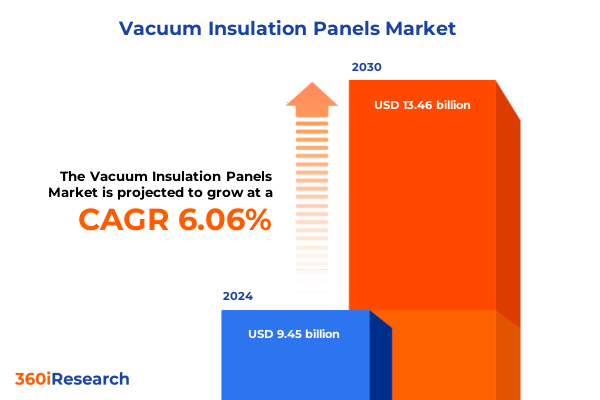The Vacuum Insulation Panels Market size was estimated at USD 9.45 billion in 2024 and expected to reach USD 10.04 billion in 2025, at a CAGR 6.06% to reach USD 13.46 billion by 2030.

Introduction to Vacuum Insulation Panels: Reinventing Thermal Efficiency
Vacuum insulation panels (VIPs) represent a paradigm shift in thermal management, delivering superior energy efficiency compared to conventional insulation materials. By minimizing heat transfer through a near-vacuum core, VIPs achieve unprecedented R-values per inch, making them indispensable for applications where space is at a premium and performance cannot be compromised. As global emphasis on sustainability intensifies, VIP technology is emerging as a critical enabler of net-zero building targets and energy-efficient refrigeration equipment. With demand driven by stringent building codes, government incentives for green construction, and rising energy costs, stakeholders across the supply chain-from raw material suppliers to end-use manufacturers-are investing heavily in research and development. This executive summary synthesizes the most pressing market developments, regulatory influences, and competitive dynamics shaping the VIP landscape today.
Transformative Shifts Redefining the Vacuum Insulation Panel Landscape
Over the past decade, vacuum insulation panels have transitioned from niche laboratory products to mainstream components in high-performance buildings and cold-chain logistics. Advancements in barrier film technology have bolstered durability, extending panel life cycles and reducing degradation rates. Meanwhile, innovations in core materials-ranging from glass fiber matrices to advanced fumed silica formulations-have improved thermal performance while lowering production costs. These technological leaps coincide with a surge in sustainability mandates, prompting building owners to prioritize ultra-thick insulation in minimal space. Concurrently, increased collaboration between material scientists and polymer specialists has fueled the development of eco-friendly barrier laminates, aligning product design with circular economy principles. As a result, the market is transitioning toward value-added solutions that not only meet but exceed evolving regulatory benchmarks, creating fresh avenues for differentiation and growth.
Assessing the Cumulative Impact of United States Tariffs in 2025
In 2025, newly imposed United States tariffs on imported vacuum insulation panels and precursor materials have introduced a layer of complexity to an already dynamic market. Import duties ranging from 10 to 25 percent on core components have led manufacturers to reevaluate sourcing strategies, prompting many to explore domestic supply alternatives or regional free-trade zones. These measures have increased landed costs for international vendors, resulting in upward price adjustments throughout the distribution chain. At the same time, U.S. manufacturers are scaling up capacity through renewed investments in local production, seeking to capitalize on reshoring incentives and mitigate tariff exposure. The combined effect of higher import duties, evolving trade agreements, and localized expansion efforts is a redistribution of value and a recalibration of competitive positioning within the North American VIP market.
Key Segmentation Insights: Application and Core Material Perspectives
Analysis of application-based and material-based segments reveals nuanced demand patterns. Within construction applications, VIP adoption is especially strong in commercial buildings where space constraints and energy codes drive specification of ultra-thin insulation solutions, while residential retrofits are increasingly leveraging VIPs to achieve aggressive energy targets in heritage structures. On the materials front, fiberglass core panels are valued for balanced cost and thermal performance, whereas advanced silica cores-particularly those formulated from fumed silica-offer higher insulation metrics and longer lifespan. Precipitated silica variants, meanwhile, strike a middle ground, delivering robust performance with scalable manufacturing. By understanding the interplay between building sector, performance requirements, and core material attributes, suppliers can tailor value propositions to segment-specific priorities and capture premium margins.
This comprehensive research report categorizes the Vacuum Insulation Panels market into clearly defined segments, providing a detailed analysis of emerging trends and precise revenue forecasts to support strategic decision-making.
- Application
- Core Material
Key Regional Insights: Global Market Dynamics Unveiled
Regional dynamics underscore a diverse array of growth drivers and adoption rates. In the Americas, the combination of aggressive energy efficiency mandates in the United States and Canada’s cold-climate insulation needs has fostered strong uptake in both new construction and retrofit markets, supported by tax credits and utility rebate programs. Europe, the Middle East & Africa exhibit a dual narrative: Western European nations are pushing VIPs into ultra-efficient façades and refrigeration-equipment markets under the EU’s Green Deal, while select Middle Eastern countries are deploying VIP-enabled modular construction to expedite sustainable urban projects. Across Asia-Pacific, rapid infrastructural expansion in China, Japan and Australia is driving large-scale integration of VIPs in transport refrigeration and commercial real estate, with domestic manufacturers scaling volumes to meet regional demand.
This comprehensive research report examines key regions that drive the evolution of the Vacuum Insulation Panels market, offering deep insights into regional trends, growth factors, and industry developments that are influencing market performance.
- Americas
- Asia-Pacific
- Europe, Middle East & Africa
Key Company Insights: Leaders Shaping the VIP Market
A cohort of established and emerging players is defining the competitive landscape. Material innovators like Evonik Industries AG and Fujian Super Tech Advanced Material Co., Ltd. are advancing silica-based core formulations, while conglomerates such as Covestro AG and Panasonic Corporation leverage polymer expertise to refine barrier film properties. Specialist manufacturers including Kingspan Group and Knauf Insulation d.o.o. integrate VIPs into comprehensive building-envelope solutions, whereas Morgan Advanced Materials Plc and Vaku-Isotherm GmbH target performance-critical refrigeration applications. At the same time, agile newcomers such as Kevothermal and Zerothermo Technology Co.,LTD. are carving niches through cost-optimized manufacturing and streamlined distribution models. Collaborative ventures between firms like CSafe Global and Etex Building Performance NV underscore the value of cross-sector partnerships in expanding use cases and accelerating market penetration.
This comprehensive research report delivers an in-depth overview of the principal market players in the Vacuum Insulation Panels market, evaluating their market share, strategic initiatives, and competitive positioning to illuminate the factors shaping the competitive landscape.
- AVERY DENNISON CORPORATION
- BuildingGreen, Inc.
- Covestro AG
- CSafe Global
- Etex Building Performance NV
- Evonik Industries AG
- Fujian Super Tech Advanced Material Co., Ltd.
- KCC CORPORATION
- Kevothermal
- Kingspan Group
- Knauf Insulation d.o.o.
- Morgan Advanced Materials Plc
- Panasonic Corporation
- PHC Corporation
- Recticel SA.
- SHANGHAI TANCHAIN NEW MATERIAL TECHNOLOGY CO., LTD.
- Va-Q-Tec AG
- Vaku -Isotherm GmbH
- Zerothermo Technology Co.,LTD.
Actionable Recommendations for Industry Leaders to Capitalize on Emerging Trends
To capitalize on emerging market dynamics and mitigate tariff impact, industry participants should prioritize several strategic initiatives. First, invest in R&D collaborations to develop proprietary core-film synergies that deliver differentiated thermal performance, thereby justifying premium pricing. Second, diversify supply chains by establishing strategic partnerships in low-tariff jurisdictions and near-shore manufacturing hubs, ensuring continuity amid trade policy shifts. Third, engage with regulatory bodies to advocate for favorable standards and incentive programs, positioning VIPs as essential components in sustainable building codes. Fourth, expand into adjacent markets such as high-end refrigeration or modular housing systems, leveraging existing capabilities to unlock incremental revenue streams. Finally, implement targeted marketing campaigns that highlight lifecycle cost savings and carbon reduction benefits to decision-makers in architecture, real estate development, and cold-chain logistics.
Explore AI-driven insights for the Vacuum Insulation Panels market with ResearchAI on our online platform, providing deeper, data-backed market analysis.
Ask ResearchAI anything
World's First Innovative Al for Market Research
Conclusion: Charting the Future of Vacuum Insulation Panel Innovation
Vacuum insulation panels stand at the intersection of technological innovation and sustainability imperatives. As regulatory landscapes tighten and environmental goals become more ambitious, VIPs will continue to outpace traditional insulation solutions in both performance and market relevance. Companies that anticipate shifts in trade policy, invest in advanced material science, and forge strategic alliances will capture the lion’s share of growth. Moreover, a commitment to transparency-through rigorous third-party testing and lifecycle analyses-will reinforce confidence among specifiers and end users alike. By integrating these strategic priorities into corporate roadmaps, stakeholders can secure a leadership position in the evolving VIP ecosystem and drive enduring value for customers and investors.
This section provides a structured overview of the report, outlining key chapters and topics covered for easy reference in our Vacuum Insulation Panels market comprehensive research report.
- Preface
- Research Methodology
- Executive Summary
- Market Overview
- Market Dynamics
- Market Insights
- Cumulative Impact of United States Tariffs 2025
- Vacuum Insulation Panels Market, by Application
- Vacuum Insulation Panels Market, by Core Material
- Americas Vacuum Insulation Panels Market
- Asia-Pacific Vacuum Insulation Panels Market
- Europe, Middle East & Africa Vacuum Insulation Panels Market
- Competitive Landscape
- ResearchAI
- ResearchStatistics
- ResearchContacts
- ResearchArticles
- Appendix
- List of Figures [Total: 20]
- List of Tables [Total: 186 ]
Call-To-Action: Engage with Ketan Rohom to Unlock In-Depth Market Intelligence
For a comprehensive deep-dive into market dynamics, competitive benchmarking, and actionable intelligence tailored to your strategic objectives, contact Ketan Rohom, Associate Director of Sales & Marketing. His expertise will guide you through customized research findings, enabling you to fast-track product development, optimize market entry strategies, and reinforce stakeholder engagement. Reach out today to secure your competitive edge and accelerate decision-making with expert insights that empower your growth trajectory.

- How big is the Vacuum Insulation Panels Market?
- What is the Vacuum Insulation Panels Market growth?
- When do I get the report?
- In what format does this report get delivered to me?
- How long has 360iResearch been around?
- What if I have a question about your reports?
- Can I share this report with my team?
- Can I use your research in my presentation?




